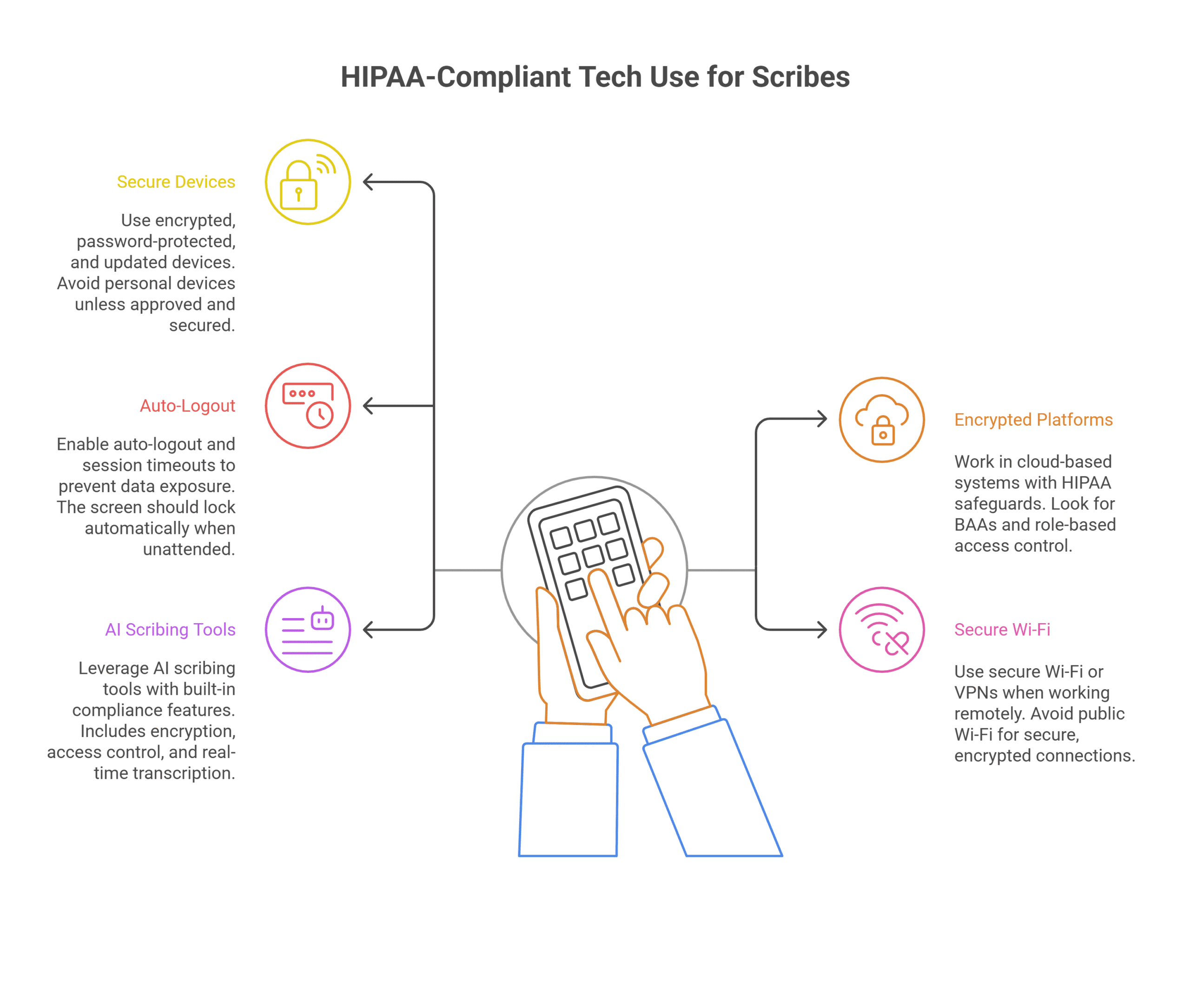On-Demand Outsourcing BPO Services for Healthcare Providers With 24/7 Coverage!
Save up to 70% on staffing costs!
Browse Specialty Staffing ServicesHow Can Medical Scribes Utilize Technology While Ensuring HIPAA Compliance?

Let’s face it—technology has completely transformed how we do medical documentation. Whether you’ve got a live scribe in the office or a virtual or AI-powered one working remotely, the convenience is unbeatable. But here’s the catch: the more tech involved, the higher the stakes for HIPAA compliance.
So, how do you take advantage of tools like remote EMR access, voice recognition, and real-time transcription—without risking a HIPAA violation? Let’s walk through it, step by step.
Key Takeaways
-
Scribes must use encrypted, secure platforms when documenting patient information.
-
Technology should enhance compliance, not compromise it—think access controls, audits, and secure cloud systems.
-
AI scribing tools must meet HIPAA requirements for data storage, access, and transmission.
-
Staffingly, Inc. provides HIPAA-compliant tech and scribe training, so providers don’t have to worry about security gaps.
Tech Makes Scribing Better—But It Has to Be Smart
Technology isn’t the enemy here—it’s a lifesaver. From faster notes to real-time access across multiple locations, it’s made the role of the medical scribe more efficient than ever.
But tech only works if it’s secure. Otherwise, you’re just opening the door to data breaches, accidental disclosures, and possible legal action under HIPAA. That’s why medical scribes must be trained to use technology that’s built with compliance in mind.
Key Ways Medical Scribes Can Use Technology and Stay HIPAA-Compliant
Here’s what smart, safe, and HIPAA-compliant tech use looks like for medical scribes:
1. Only Use HIPAA-Secure Devices
Whether it’s a laptop, tablet, or voice-to-text software:
-
Devices must be encrypted, password-protected, and kept up to date.
-
Avoid using personal devices unless they’ve been approved and secured.

2. Work in Encrypted EMR and Scribing Platforms
-
Use cloud-based systems with built-in HIPAA safeguards.
-
Look for platforms that offer business associate agreements (BAAs) and role-based access control.
3. Enable Auto-Logout and Session Timeouts
-
If a scribe steps away from the screen, it should lock automatically.
-
This prevents accidental data exposure in shared or remote environments.
4. Use Secure Wi-Fi or VPNs
-
Scribes working remotely should never use public Wi-Fi.
-
Instead, use VPNs to create secure, encrypted connections.
5. Leverage AI Scribing Tools with Built-In Compliance
-
Staffingly’s AI medical scribing tools come equipped with:
-
End-to-end encryption
-
User access control
-
Real-time transcription within HIPAA-compliant environments
-
What About AI-Powered Scribing?
AI is quickly becoming a top choice for medical scribing—but just because it’s automated doesn’t mean it’s risk-free.
Staffingly, Inc.’s AI scribing solutions are fully HIPAA-compliant and built for healthcare from the ground up. That means:
-
No data is stored locally
-
All transmissions are encrypted
-
Access is restricted to authorized users only
-
Full audit logs are available for traceability
So yes—AI can be just as compliant as a live scribe, if it’s done right.
Why Training Still Matters?
You can have the best tech in the world, but if someone clicks the wrong thing or leaves their screen unlocked, you’re still exposed.
That’s why Staffingly, Inc. trains every medical scribe on HIPAA best practices, including:
-
Secure device usage
-
How to handle voice or video-based dictation
-
What to do in the event of a potential breach
Good tech and great habits go hand in hand.
What Did We Learn?
Medical scribes can absolutely use technology and still follow HIPAA rules—as long as they use secure systems and receive the right training.
If you’re working with live scribes or relying on AI-powered tools, Staffingly, Inc. makes sure everything runs securely. Their solutions are designed for real-world healthcare documentation, so you get notes that are accurate, timely, and HIPAA-safe.
What People Are Asking?
Q: Can scribes work from home and still follow HIPAA rules?
A: Absolutely. With encrypted tools, secure networks, and ongoing training, remote scribes can document patient info safely.
Q: Does AI scribing meet HIPAA standards?
A: It can—if the system uses encryption, limits user access, and follows HIPAA-focused design. That’s exactly what Staffingly’s platform does.
Q: What’s the biggest HIPAA risk when scribes use technology?
A: Using unsecured devices or public Wi-Fi. That’s why scribes need encrypted systems and VPNs every time they log in.
Q: Who’s held responsible if a breach happens due to tech use?
A: The provider always carries the responsibility. That’s why choosing a compliant partner like Staffingly, Inc. is essential.
Disclaimer
For informational purposes only; not applicable to specific situations.
For tailored support and professional services,
Please contact Staffingly, Inc. at (800) 489-5877
Email : support@staffingly.com.
About This Blog : This Blog is brought to you by Staffingly, Inc., a trusted name in healthcare outsourcing. The team of skilled healthcare specialists and content creators is dedicated to improving the quality and efficiency of healthcare services. The team passionate about sharing knowledge through insightful articles, blogs, and other educational resources.
 Book a Demo to Build Your Team Today!
Book a Demo to Build Your Team Today!

 Read Case Studies
Read Case Studies 


 Virtual Medical Assistants
Virtual Medical Assistants



